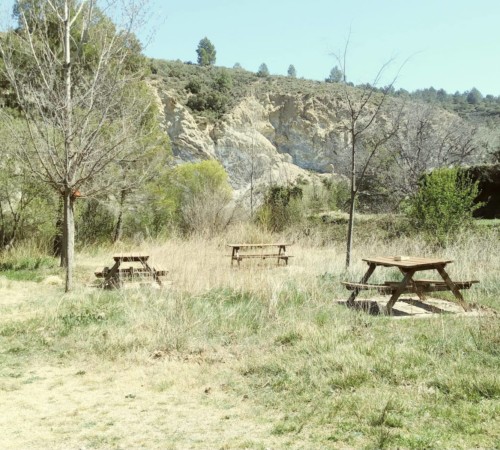In Bejís, located between the long mountain ranges of El Toro and Andilla, at 800 metres altitude, and close to the limit with Teruel Province it is the campsite of Los Cloticos which converges with a forest heritage area and plenty of attractive and evoking corners.
From the Roman Age remains the aqueduct, which was declared a national monument and whose excellent water comes from the Fountain of los Cloticos. A privileged area with abundant and diverse flora and fauna of high ecological value. There are many breathtaking beautiful places: the source of the Rio Palancia and the natural landscape of Peñaescabia, where there were found some Dinosaur footprints.
In addition to the direct access from the campsite, the source of the River Palancia is located just 4 km away, which is a spectacular route and easily accessible.
Además del acceso directo desde el camping, el nacimiento del río Palancia se encuentra a 4km, siendo una ruta muy bonita y de fácil acceso.
-
La Aldea del Molinar (The Molinar’s village): It is a really picturesque, little and charming place. It is situated next to the River Palancia and it has two stunning natural pools, which are the meeting point of the river Palancia, Resinero and the Agua Lobos’ cliff. In summer, swimmers enjoy its crystalline water. This little village is just 1 km away from the campsite.
- Parish: It is dedicated to Nuestra Señora de los Ángeles (Our Lady of the Angels) and it has a Renaissance fountain and a garden courtyard surrounded by the arches that before belonged to the old City Hall.
- Ermita de San Juan en Arteas de Abajo: The hermitage was built in the XVI century under a popular style.
- Ermita de la Virgen de Loreto:
- El Acueducto: It belongs to the Roman Age but it has been restored in accordance with the present times, declared to be a Property of Cultural Interest.
- El Castillo: Although nowadays it is in ruins, it is made up of three fortress and three wells. Nowadays there could still be observed several murals as well as silos and cisterns.
- El Granero del Infante: It is a XV century old barn which has been rebuild and maintains two lovely original blazons showing the cross of the Calatrava Order.
- It is located to the right and takes us to El Toro, 12 km away, a route with views to a leafy pine and Holm oak forest.
- Peña Escabia: It is a rock mountain formation visible from almost all the Alto Palancia region, located at 1.221 m altitude and it is a protected area as a Natural Park.
- Las peñas de Amador: Located at 1.134 m above the sea level “s.n.m” are wonderful limestone rock formations placed behind the campsite where on the top there is a forest watchtower. The distance from the campsite to Amador’s Crags is 2 hours walking and offers stunning views.
As for the fauna, we will able to contemplate huge bird colonies like the Griffon vulture in Peñascabia, a couple Egyptian vultures that have nested in Peñas de Amador, a Bonelli’s eagle, different kinds of falcons, nocturnal birds of pray like the tawny owl or the eagle owl. There are also some carnivore animals like the fox, otters and some herbivores like the roe deer, mountain goats and the wild boar. It means that there is a great fauna to discover.
- La Luz:
Leisure area next to the river, a perfect place to do a picnic and enjoy the nature.
- Ichnites’ Route, after the dinosaurs footprints
The oldest register is represented by the archaeological site of icnitas in Bejís dated from approximately 230 billion years old and also, it is one of the oldest vertebrates ichnitological sites from the Iberian Peninsula. There is only a kittiwake footprint that could belong to a reptile the codont, a direct ancestor of the dinosaurs.




















